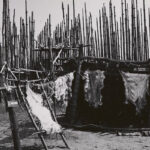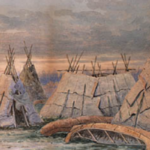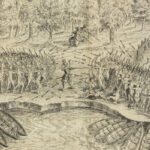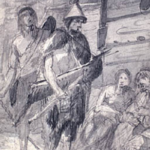Batchewana First Nation: A Legacy of Anishinaabe Resilience and Continuity
The Batchewana First Nation, located along the shores of Lake Superior near Sault Ste. Marie, Ontario, embodies the rich history and enduring traditions of the Anishinaabe (Ojibwe) people. With roots that stretch back thousands of years, Batchewana’s story is one of adaptation and resilience, deeply intertwined with the land and water that have sustained the community for generations. From their pre-contact origins and early interactions with European explorers to their modern development, the Batchewana First Nation stands as a testament to the strength of the Anishinaabe people.
Pre-History: Anishinaabe Roots Along Lake Superior
The Anishinaabe people, to whom the Batchewana First Nation belongs, trace their ancestry to ancient communities that migrated westward from the Atlantic coast, guided by the Seven Fires Prophecy. This migration, a spiritual and physical journey, brought the Anishinaabe to the Great Lakes region, including the northern shores of Lake Superior, where they found an abundance of resources to sustain their way of life.
The name Batchewana derives from the Anishinaabe word Badjiwanung, meaning “water that bubbles up,” a reference to the swift currents at the mouth of the Batchawana River. The river and the surrounding forests provided fish, game, and plants for sustenance, while the pristine waters of Lake Superior served as a vital transportation route. These natural resources not only sustained the community but also shaped their cultural and spiritual practices.
Anthropologist Robin Ridington, in Trail to Heaven: Knowledge and Narrative in a Northern Native Community, reflects on the Anishinaabe relationship with the land: “For the Anishinaabe, the land and water were sacred, imbued with spiritual significance that guided their daily lives and cultural practices.”
Governance and Social Structure
The governance of the Anishinaabe, including the Batchewana people, was rooted in respect for the land and a commitment to consensus-based decision-making. Leaders, or ogimaag, were chosen for their wisdom, courage, and ability to guide the community through challenges. Elders held a revered place in society, passing down oral histories, teachings, and spiritual knowledge.
The dodem (clan) system, a fundamental aspect of Anishinaabe social organization, structured the community into kinship groups with specific roles and responsibilities. This system ensured balance and harmony within the community, fostering a sense of unity that would prove vital in navigating the challenges brought by European contact.
First Contact with European Explorers
The arrival of European explorers in the 17th century marked a turning point in the history of the Batchewana people. French traders and Jesuit missionaries were among the first Europeans to interact with the Anishinaabe of Lake Superior. These early encounters were largely shaped by the fur trade, which connected the Anishinaabe to global markets and introduced goods such as firearms, metal tools, and textiles.
The Anishinaabe of Batchewana played a key role as trappers, guides, and intermediaries, facilitating trade between European merchants and more remote Indigenous communities. While the fur trade brought material benefits, it also introduced challenges, including overharvesting of fur-bearing animals and the spread of European diseases like smallpox, which devastated Indigenous populations.
Historian Bruce Trigger, in Indigenous Peoples of Canada, notes, “The fur trade was a double-edged sword for Indigenous nations, offering new opportunities while disrupting traditional economies and exposing communities to profound risks.”
Relationships with French and British Settlers
The strategic location of Batchewana near Sault Ste. Marie, a critical junction for the Great Lakes trade routes, made the community an important player in the colonial power struggles between the French and British. During the Seven Years’ War (1756–1763) and later the War of 1812, the Anishinaabe allied with these powers at different times to protect their lands and sovereignty.
In the aftermath of these conflicts, British settlement in the region increased, bringing new pressures on Anishinaabe lands. Treaties became a primary mechanism for negotiating land use and access to resources. The Robinson-Huron Treaty of 1850, signed by the Anishinaabe of Batchewana and other communities, ceded vast tracts of land in exchange for annuities and the promise of continued hunting and fishing rights. While the treaty provided a framework for coexistence, its implementation often fell short of its original intentions.
The Development of the Reserve System
The establishment of reserves under the Indian Act (1876) confined Indigenous communities to small portions of their traditional territories. The Batchewana reserve lands, initially established along the shores of Lake Superior, became the focal point of the community’s life. However, the reserve system disrupted traditional governance and limited access to vital resources, forcing the Batchewana people to adapt to a new way of life.
The imposition of residential schools further compounded these challenges. Children from Batchewana were forcibly removed from their families and sent to institutions where they were prohibited from speaking Anishinaabemowin (Ojibwe language) or practising their traditions. These schools sought to assimilate Indigenous children into Euro-Canadian society, leaving a legacy of trauma that continues to affect the community today.
Cultural Resilience and Revitalization
Despite the disruptions of colonization, the Batchewana First Nation has demonstrated remarkable resilience. Efforts to preserve and revitalise Anishinaabemowin and restore traditional ceremonies have been central to the community’s resurgence. Elders and educators have worked tirelessly to pass on knowledge of traditional practices, such as fishing, trapping, and wild rice harvesting.
Annual events, such as the Batchewana Powwow, celebrate the rich cultural heritage of the community, providing opportunities for storytelling, drumming, and dancing. These gatherings reinforce the pride and identity of the Batchewana people and serve as a reminder of their enduring connection to their history and traditions.
Environmental Stewardship and Advocacy
The Batchewana First Nation has long been a steward of the lands and waters surrounding Lake Superior. Traditional ecological knowledge informs their sustainable practices in hunting, fishing, and land management. The community has taken a leading role in addressing environmental challenges, such as pollution and the impact of industrial development on their territory.
Partnerships with environmental organizations and local governments have furthered these efforts, ensuring that the natural resources of Lake Superior are protected for future generations. Chief Dean Sayers, in a 2020 address, emphasized, “Our connection to the land and water is not just cultural but essential to our survival. We have a responsibility to protect these resources for those who come after us.”
Batchewana First Nation Today
Today, the Batchewana First Nation is a thriving community with a population of over 3,000 members, many of whom live on reserve lands. The community has successfully blended traditional practices with modern governance and economic development. Investments in renewable energy, education, and housing reflect their commitment to sustainability and self-determination.
The Batchewana First Nation continues to advocate for treaty rights and land claims, working to address historical injustices and secure a brighter future for their people. Their efforts serve as a powerful example of resilience and determination in the face of adversity.
Conclusion: A Legacy of Strength and Continuity
The history of the Batchewana First Nation is a testament to the strength, adaptability, and enduring spirit of the Anishinaabe people. From their ancient roots along the shores of Lake Superior to their modern efforts in cultural revitalization and environmental advocacy, the Batchewana people have maintained their identity and place within Canada’s evolving landscape.
As Chief Dean Sayers stated, “Our story is one of resilience and pride. By honouring our past and protecting our future, we ensure that the legacy of the Batchewana First Nation continues to thrive.”
References
- Ridington, Robin. Trail to Heaven: Knowledge and Narrative in a Northern Native Community. Douglas & McIntyre, 1988.
- Trigger, Bruce G. Indigenous Peoples of Canada. McGill-Queen’s University Press, 1992.
- Johnston, Basil. Ojibway Heritage. McClelland & Stewart, 1976.
- Harris, Cole. The Resettlement of British Columbia: Essays on Colonialism and Geographical Change. UBC Press, 1997.
- Conrad, Margaret. A Concise History of Canada. Cambridge University Press, 2012.
- Batchewana First Nation. Guardians of Lake Superior: The History and Culture of Batchewana. Batchewana Publications, 2015.
- Sayers, Dean. “Protecting Our Land: The Vision of Batchewana First Nation.” CBC News, 2020.
- Treaty Elders of Ontario. Voices of the Lake: Stories from Anishinaabe Communities. University of Toronto Press, 2005.
- Environmental Justice Advocacy Group. Stewardship and Sustainability: The Role of Batchewana in Environmental Advocacy. University of Guelph Press, 2018.
- Williams, Dorothy. Treaties and Traditions: The Legacy of the Robinson-Huron Treaty. University of Toronto Press, 2009.



